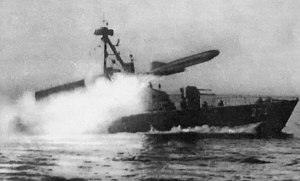Komar-class missile boat
This article includes a list of general references, but it lacks sufficient corresponding inline citations. (April 2009) |
 A Komar-class missile boat launching a Styx missile
| |
| Class overview | |
|---|---|
| Name | Komar (Project 183R) |
| Operators | |
| Succeeded by | Osa class |
| Subclasses | Project 183 (MTB) |
| Built | 1952-1960 |
| Completed | 112 missile boats |
| General characteristics | |
| Type | Missile boat |
| Displacement | 61.5 tons standard, 66.5 tons full load |
| Length | 25.4 m (83 ft 4 in) |
| Beam | 6.24 m (20 ft 6 in) |
| Draught | 1.24 m (4 ft 1 in)[a] |
| Propulsion | 4 shaft M-50F diesels 4,800 hp (3,600 kW) |
| Speed | 44 knots (81 km/h; 51 mph) |
| Range | 600 nmi (1,100 km; 690 mi) at 32 knots (59 km/h; 37 mph) |
| Crew | 17 (3 officers) |
| Sensors and processing systems | |
| Armament |
|
The Soviet Project 183R class, more commonly known as the Komar class, its NATO reporting name, meaning "mosquito", is a class of missile boats, the first of its kind, built in the 1950s and 1960s. Notably, they were the first to sink another ship with anti-ship missiles in 1967.
Design[edit]
The Project 183 motor torpedo boat (MTB) was designed just after World War II. These boats were armed with two 533 mm (21 in) torpedo tubes and were used extensively by Soviet coastal forces in the 1950s. The torpedo boat had a wooden semi-planing hull and was fitted with radar. Over 622 MTBs were built. A submarine chaser variant fitted with sonar and depth charges was also built as was a radio-controlled target boat.
In 1956, the P-15 Termit missile became available (NATO reporting name: SS-N-2 "Styx"). The Project 183 proved to be a natural choice for mounting the new missiles, giving the small, fast boats great firepower for their size. The new combination was designated Project 183R (R apparently for raketny - rocket), the first[citation needed] missile boat in service anywhere in the world. The missiles could be fired in sea state 4.
A total of 112 Komars were built between 1956 and 1965 and served in the Soviet Navy, along with several allied navies, until the 1980s, when they were replaced by newer, more capable fast attack craft.
Export ships[edit]
 Algerian National Navy - 6 boats 1967
Algerian National Navy - 6 boats 1967 People's Liberation Army Navy - 8 boats (1961) plus about 40 built under licence. The Chinese also built a steel-hulled derivative as the Type 024 class missile boat
People's Liberation Army Navy - 8 boats (1961) plus about 40 built under licence. The Chinese also built a steel-hulled derivative as the Type 024 class missile boat Cuban Revolutionary Navy - 18 boats
Cuban Revolutionary Navy - 18 boats Egyptian Navy - 7 boats (1962–67), retired in the early 1990s; The Egyptian Navy built 6 derivative boats equipped with western weapons and electronics in the early 1980s as the October class
Egyptian Navy - 7 boats (1962–67), retired in the early 1990s; The Egyptian Navy built 6 derivative boats equipped with western weapons and electronics in the early 1980s as the October class Indonesian Navy - 12 boats (1961–65)
Indonesian Navy - 12 boats (1961–65) Iraqi Navy - 3 boats (1972)
Iraqi Navy - 3 boats (1972) Myanmar Navy - 6 boats donated between 1969 and 1974, all retired between 1998 and 2002.
Myanmar Navy - 6 boats donated between 1969 and 1974, all retired between 1998 and 2002. Korean People's Navy - 10 boats
Korean People's Navy - 10 boats Syrian Arab Navy - 9 boats
Syrian Arab Navy - 9 boats Vietnam People's Navy - 4 boats
Vietnam People's Navy - 4 boats
Combat use[edit]
- 1967 October 21 - Egyptian Navy Komar-class missile boats sank Israeli destroyer Eilat in the first combat use of P-15 Termit anti-ship missiles. This was the first time a ship had sunk another ship using guided missiles.
- 7 October 1973 - Two Syrian Navy Komar-class missile boats along with an Osa I-class missile boat, a K-123 torpedo boat and a T43-class minesweeper fought unsuccessfully against four Israeli Navy Sa'ar 3-class missile boats and one Sa'ar 4-class missile boat in the Battle of Latakia. Other Syrian missile boats fired missiles from within the harbor that mistakenly or due to malfunction hit civilian craft in the harbour.
- 1974 January 19 - 4 People's Liberation Army Navy Komar-class joined Battle of the Paracel Islands in Vietnam War
See also[edit]
Notes[edit]
References[edit]
- ^ Couhat Jean. Combat Fleets of the world 1982/1983 Their Ships, Aircraft, and Armament Paris: Editions Maritimes et d'Outre-Mer, 1981 ISBN 0-87021-125-0 p. 2
Bibliography[edit]
- Gardiner, Robert, ed. (1995). Conway's All the World's Fighting Ships 1947–1995. London: Conway Maritime. ISBN 0851776051. OCLC 34284130.
- Also published as Gardiner, Robert; Chumbley, Stephen; Budzbon, Przemysław (1995). Conway's All the World's Fighting Ships 1947–1995. Annapolis, MD: Naval Institute Press. ISBN 1557501327. OCLC 34267261.
External links[edit]
- Missile boat classes
- Missile boats of the Soviet Navy
- Cold War missile boats of the Soviet Union
- Missile boats of the Algerian National Navy
- Missile boats of the Cuban Navy
- Cold War missile boats of Cuba
- Missile boats of the Egyptian Navy
- Missile boats of the Indonesian Navy
- Missile boats of the Iraqi Navy
- Missile boats of the Korean People's Navy
- Cold War missile boats of North Korea
- Missile boats of the People's Liberation Army Navy
- Missile boats of the Syrian Navy
- Missile boats of the Vietnam People's Navy
